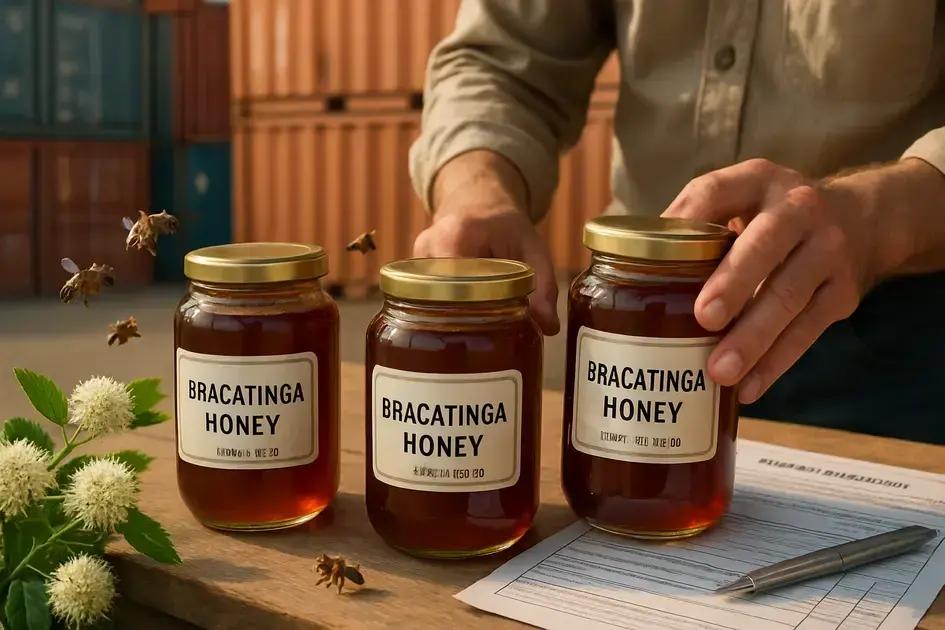=
Bracatinga honey in global markets is a premium natural product prized for its unique floral origin, rich antioxidants, and sustainable production, with growing demand in North America, Europe, and Asia driven by health-conscious consumers and expanding specialty food sectors.
Have you ever wondered what makes Bracatinga honey in global markets so sought after? This special honey, famous for its unique flavor and benefits, is gaining attention from buyers around the world. Let’s dive into why this demand is growing and what it means for producers and consumers alike.
Origins and characteristics of Bracatinga honey
Bracatinga honey is a unique type of honey produced primarily from the nectar of the Bracatinga tree (Mirabilis jalapa), native to Brazil. This honey is highly valued for its distinct taste, color, and rich nutritional profile. The harvesting season is typically short, lasting only a few weeks during the flowering period, which makes Bracatinga honey relatively rare and sought-after.
Floral source and environment
The Bracatinga tree grows mainly in the Brazilian Atlantic Forest and Cerrado biome regions. Bees collect nectar from these blooms, resulting in honey with a smooth texture and a slightly herbal and floral flavor. The climate and soil quality of these areas deeply influence the honey’s quality and consistency.
Nutritional and sensory features
This honey is known for its high antioxidant content and rich mineral composition, which contribute to its health benefits. Its color ranges from amber to dark golden. The aroma is pleasant and distinctive, which helps it stand out in global markets.
Harvest and production process
Due to the short bloom of the Bracatinga tree, beekeepers must carefully time their harvest to capture the honey at its peak quality. Sustainable practices are encouraged to prevent overharvesting and to maintain the biodiversity of the Bracatinga ecosystem.
Current trends in global honey demand
Global demand for honey has been rising steadily, driven by consumers seeking natural sweeteners and health benefits. Bracatinga honey is gaining attention due to its unique taste and rich nutritional properties, which differentiate it from other honey types. This growing interest is reflected in increasing imports and expanding markets worldwide.
Health and wellness influence
Consumers are more health-conscious today, preferring honey over refined sugars because of its antioxidants and vitamins. Bracatinga honey, with its high antioxidant content, benefits from this trend as a premium natural product.
Sustainability and organic preferences
There is a rising preference for sustainably sourced and organic products. Bracatinga honey often aligns with these values due to its natural harvesting methods and association with protected forest areas, appealing to eco-conscious buyers.
Market diversification and new opportunities
Markets in North America, Europe, and Asia are showing increased interest in exotic and specialty honeys like Bracatinga honey. This diversification offers new opportunities for producers and exporters to expand their reach.
Key global markets for Bracatinga honey
Bracatinga honey is finding strong markets in several global regions due to its unique flavor and health benefits. Key markets include North America, Europe, and parts of Asia, where consumers seek natural and specialty honey varieties.
North America
In North America, there is growing demand for premium natural sweeteners, especially among health-conscious consumers. Specialized stores and online markets actively feature Bracatinga honey as an exotic and beneficial product.
Europe
European countries value quality and sustainability. Bracatinga honey’s organic harvesting methods and rich antioxidant properties make it attractive in countries like Germany, France, and the UK, where consumers favor natural foods.
Asia
Rising income levels and increasing interest in wellness products have created new opportunities in Asian markets, including China, Japan, and South Korea. Bracatinga honey fits well with traditional and modern health trends in these regions.
Other emerging markets
Developing countries in Latin America and the Middle East are beginning to explore Bracatinga honey as part of their growing specialty food markets, driven by tourism and increased appreciation for natural products.
Challenges facing Bracatinga honey exporters

Exporters of Bracatinga honey face several challenges that can impact their success in global markets. These include logistical hurdles, quality control, and regulatory compliance across different countries.
Logistical challenges
Transporting honey internationally requires careful handling to maintain product integrity. Issues like temperature control during shipping and delays at customs can affect honey quality, especially since Bracatinga honey is prized for its freshness.
Quality standards and certifications
Different markets demand various quality certifications such as organic labels or sanitary approvals. Ensuring Bracatinga honey meets these standards can be complex and costly, requiring exporters to invest in proper testing and documentation.
Competition and pricing pressures
Bracatinga honey faces competition from other well-known honeys worldwide. Exporters must balance between pricing competitively and maintaining sustainable production practices to keep product value.
Environmental and sustainability concerns
Sustainability protocols are increasingly important. Exporters need to protect bee populations and Bracatinga habitats while promoting environmentally friendly harvesting methods to appeal to ethical consumers.
Sustainability and environmental impacts
Sustainability plays a key role in the production and trade of Bracatinga honey. Responsible beekeeping helps protect the delicate ecosystems where Bracatinga trees grow, ensuring long-term environmental health and honey quality.
Environmental benefits of Bracatinga honey production
Bees that collect nectar from Bracatinga trees support local biodiversity by pollinating various plant species. This interaction helps maintain forest health and contributes to carbon capture, which combats climate change.
Practices promoting sustainability
Many producers adopt sustainable methods such as avoiding overharvesting, preserving native flora, and supporting organic farming standards. These practices protect soil quality and water resources, benefiting both nature and producers.
Challenges in maintaining sustainability
Environmental threats like deforestation and climate change can impact Bracatinga tree populations and bee habitats. Exporters and beekeepers must collaborate with conservation efforts to address these challenges and safeguard the honey supply.
Consumer influence on sustainability
Consumers increasingly demand products with clear sustainability credentials. This encourages producers to adopt eco-friendly practices and promotes awareness about the environmental importance of Bracatinga honey production.
Future outlook and market opportunities
The future outlook for Bracatinga honey looks promising, as growing consumer interest in natural and exotic honey types continues to rise. Increasing demand for health-focused foods can open new market opportunities globally, especially in premium segments.
Emerging markets and expanding demand
New markets in Asia, the Middle East, and Latin America are beginning to show interest in specialty honeys. This growth presents opportunities for producers to diversify their export destinations and increase sales volume.
Innovation and product diversification
Producers and exporters can explore value-added products such as flavored honeys, honey-based cosmetics, and health supplements. Innovation within the Bracatinga honey category may attract wider consumer segments.
Sustainability as a market driver
Aligning Bracatinga honey production with sustainability practices will boost its appeal, particularly among conscious consumers. Transparent certifications and eco-friendly branding can enhance market positioning.
Collaborations and partnerships
Strategic partnerships between beekeepers, exporters, and distributors can help navigate international market requirements and improve supply chain efficiency, fostering market growth.
The growing global demand for Bracatinga honey
Bracatinga honey is gaining popularity worldwide thanks to its unique qualities and health benefits. As more consumers seek natural and sustainable products, this honey’s future looks bright.
By focusing on quality, sustainability, and innovation, producers and exporters can tap into new markets and meet global demand. Collaboration and responsible practices will play a key role in supporting this growth.
Overall, Bracatinga honey offers exciting opportunities for those willing to invest in its potential and share its unique story with the world.
FAQ – Common questions about Bracatinga honey in global markets
What makes Bracatinga honey unique compared to other types of honey?
Bracatinga honey is unique due to its floral source from the Bracatinga tree, its rich antioxidant content, and its distinct flavor and color.
Which countries are the main markets for Bracatinga honey?
Key markets include North America, Europe, and parts of Asia, where there is growing demand for natural and specialty honeys.
What are the main challenges exporters face when selling Bracatinga honey internationally?
Exporters face challenges such as logistical issues, meeting different countries’ quality certifications, pricing pressures, and environmental sustainability concerns.
How does sustainability impact Bracatinga honey production?
Sustainability practices help protect bee populations and the environment, ensuring the long-term availability and quality of Bracatinga honey.
Why is the demand for Bracatinga honey increasing worldwide?
Increasing consumer interest in natural, healthy, and sustainably sourced products is driving the rising demand for Bracatinga honey globally.
What future opportunities exist for producers of Bracatinga honey?
Producers can explore new markets, develop value-added products, and emphasize sustainability to attract conscious consumers and grow their presence internationally.


